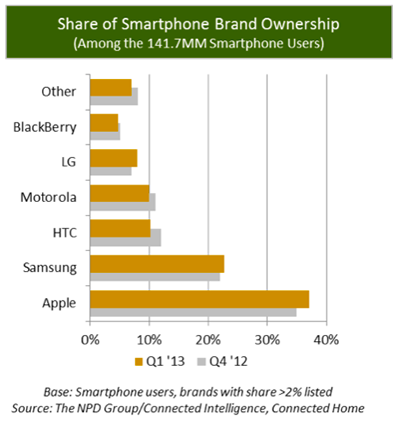Technically a Universe can consist of billions of Galaxies, but some are much larger than others. In the U.S., the Android Universe is starting to get usurped by Samsung. The latest Samsung phone, Galaxy S 4, is not just a hardware launch, but rather shows off Samsung's ability to leverage the Android bones to make a stronger overall device that is bigger than its parts.

HTC, Motorola, LG smartphone users are you going to switch and try Android on Samsung? Samsung asserts it is different, better, and more innovative. Are you an iPhone user wanting a fresh new look and feel for your phone on a larger screen? Could you really be drawn away from your affinity to Apple and the bonds you’ve formed within their eco-system? Convincing consumers to switch is challenging. But Samsung is pulling out all the stops in hopes of continuing to grab share of the growing smartphone market.
According to our new Q1 Connected Home report, over the past 3 months smartphones and tablets fueled the growth in connected devices. For the most part the mobile landscape is a battle for growth between iOS and Android OEMs. But it is starting to look more like a one-on-one match between Apple and Samsung. This is not to say that there aren’t high-end innovative phones being released by other OEMs, but the marketing and product development expenditures of these two leaders are making it increasingly challenging for other OEMs to take advantage of the mobile migration to smartphones.
Each OEM releases new phones with features aimed at finding the mix that will attract consumers to their new flagship. The release of the Galaxy S 4 appears as though Samsung’s strategy was to upgrade nearly every technical specification and add a significant number of new software features. Some prominent specs include 2GB of RAM, a max of 128GB of memory when coupling internal storage and a micro SD card, 13-mega pixel camera, and a 441ppi full HD super AMOLED 5-inch screen. Prominent features focus on the camera, adding sound to photos, including yourself in the picture you are taking, creating a digital or print photo album, leveraging Google voice commands to offer safe interaction with your phone while driving, no touch scrolling and much more. As consumers evaluate the various high-end Android options the Galaxy will be very attractive in nearly all categories.
But are iPhone users ready for something new as well? Following the release of the iPhone 5 there has been a fair bit of chatter amongst iPhone users suggesting a sizable number may be ready for something new. There is screen envy, when they view their 4-incher next to a colleague using the 5.5-inch Samsung Note II. Others say they are looking for a fresh new OS. When I asked a long time unequivocal Apple consumer, who for the first time may be a potential switcher, “Can you do it?” The response characterizes the impact of eco-system decisions. “Hmmmm. I have an iPhone, an iPad, and a Mac Book Pro. Switching would be hard.” Not every iPhone user is entrenched in the eco-system and even still technology fans love new features. But, the concept that one phone will be the Apple Killer is more hype than reality as many Apple enthusiasts will remain in the fold.
The Galaxy S 4 will inevitably drive some iPhone users to cross-over into the Samsung Galaxy. And there will be other Android users that are enticed to try Samsung as well. However, this is not the revolution we saw with the initial release of the iPhone and nor should we expect it to be. It’s not every year that one device radically changes the market landscape. Soon there will be another iPhone announcement and the hype will turn back to Cupertino. More than anything, the challenge Samsung presents with the combination of the S 4 and Note II is a product line that raises the cost of entry. They embedded a significant number of software features in a device with strong technical specifications that is eclipsing the Android infrastructure on which it’s built.


